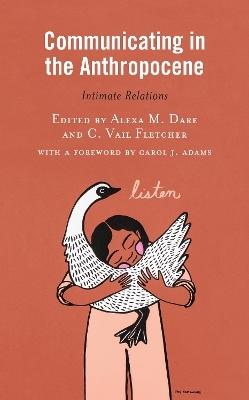
Communicating in the Anthropocene
Lexington Books (Verlag)
978-1-7936-2930-2 (ISBN)
The purpose of Communicating in the Anthropocene: Intimate Relations is to tell a different story about the world. Humans, especially those raised in Western traditions, have long told stories about themselves as individual protagonists who act with varying degrees of free will against a background of mute supporting characters and inert landscapes. Humans can be either saviors or destroyers, but our actions are explained and judged again and again as emanating from the individual. And yet, as the coronavirus pandemic has made clear, humans are unavoidably interconnected not only with other humans, but with nonhuman and more-than-human others with whom we share space and time. Why do so many of us humans avoid, deny, or resist a view of the world where our lives are made possible, maybe even made richer, through connection? In this volume, we suggest a view of communication as intimacy. We use this concept as a provocation for thinking about how we humans are in an always-already state of being-in-relation with other humans, nonhumans, and the land.
Vail Fletcher is associate professor in the Department of Communication at the University of Portland and co-director of the Gender and Women’s Studies program. Alexa Dare is associate professor of communication at the University of Portland where she also directs the social justice minor
Table of Contents
Foreword: Undisciplined Stories
Acknowledgments
Carol J. Adams
1. Introduction: Intimate Relations for Earthly Survival
Alexa Dare and C. Vail Fletcher
Part I: Grief, Resilience, and Storytelling
2. Vigilant Mourning and the Future of Earthly Coexistence
Joshua Trey Barnett
3. Presence and Absence in the Watershed: Storytelling for the Symbiocene
Emily Plec
4. The Trouble with Resilience
Jessica Holmes
5. Solastalgia and Art Therapy in Climate Change
Chelsea Call
6. Living (in) Spider Webs: More-than-Human Intimacy in Installation Art by Tómas Saraceno
Katharina Alsen
Part II: Nonhuman Collaborators: Oysters, Birds, and Elephants
7. The Permeable Heart: Mindfulness in Animal-Human Communication
Peggy J. Bowers
8. Intimacy on the Half-Shell: Place, Oysters, and the Emerging Narrative of Virginia Aquaculture
Anne K. Armstrong, Richard C. Stedman, and Marianne E. Krasny
9. i am naiad: Becoming Benthic
laura c carlson
10. Ada Clapham Govan and “Birds I Know:” Ecological Intimacy in a Mass-mediated Sisterhood
Peter W. Oehlkers and Anna Ijiri Oehlkers
11. Dialogic Elephant and Human Relations in Sri Lanka as Social Practices of Cohabitation
Elizabeth Oriel, Deepani Jayantha, and Amal Dissanayaka
12. ocean medicine, mother medicine, and sky medicine
Michaela Keeble
Part III: Plants and Other Family Members
13. Weirding Wellness: Mushrooms, Medicine, and the Uncanny Renaissance of Psilocybin in the Chthulucene
Josh Potter
14. Multispecies Motherhood: Connecting with Plants Through Processes of Procreation
Mariko Oyama Thomas
15. Plant Persons, More-Than-Human Power, and Institutional Practices in Indigenous Higher Education
Keith Williams and Suzanne Brant
16. OAK
Marybeth Holleman
17. Objects/Ecologies: Jardin d’Incertitude le système écologique et l’objet technologique
Christianna Bennett
Part IV: Nonhuman Agency, Activism and Legal Personhood
18. If the Ocean Were a Person
Jenny Rock and Ellen Sima
19. Personal Affairs: Litigating Nonhuman Animal Personhood in the Anthropocene
S. Marek Muller
20. Tahlequah’s Internatural Activism: Situating the Body and the Intimacy of Grief as Evidence of Human-Caused Climate Change
Madrone Kalil Schutten
21. Never the Same River Twice: How Legal Personhood of Rivers Affects Perceived Stability of Policy Solutions
Carie Steele
22. The Titans at the Heart of the Anthropocene: Diving into the Non-human Imagery of Leviathan
Patricia Castello Branco
23. Listen to the Lake: Nature as Stakeholder
Kathy Isaacson
24. The Geo-Doc: A Proposed New Communications Tool for Planetary Health
Mark Terry
Part V: Gender, Earthly Intimacies, and Other Trouble
25. Intimate Dwelling and Mourning Loss in the (m)Anthropocene: Ecological Masculinities and the Felt Self
Todd LeVasseur and Paul M. Pulé
26. The Climate Gaze and Koalas in Extremis
Lyn McGaurr and Libby Lester
27. From Fatbergs to Microplastics: New Intimacies of an Extruded World
Paul Alberts
28. Doğa İçin Çal (Play for Nature)
Çağrı Yılmaz
29. Subversive Art: Communicating the Climate Crisis on a Planetary Scale
Catherine Sarah Young
| Erscheinungsdatum | 26.08.2022 |
|---|---|
| Reihe/Serie | Environmental Communication and Nature: Conflict and Ecoculture in the Anthropocene |
| Co-Autor | Carol Adams, Paul Alberts, Katharina Alsen |
| Verlagsort | Lanham, MD |
| Sprache | englisch |
| Maße | 151 x 230 mm |
| Gewicht | 694 g |
| Themenwelt | Sachbuch/Ratgeber ► Natur / Technik ► Natur / Ökologie |
| Schulbuch / Wörterbuch ► Wörterbuch / Fremdsprachen | |
| Sozialwissenschaften ► Kommunikation / Medien ► Allgemeines / Lexika | |
| Sozialwissenschaften ► Kommunikation / Medien ► Kommunikationswissenschaft | |
| ISBN-10 | 1-7936-2930-7 / 1793629307 |
| ISBN-13 | 978-1-7936-2930-2 / 9781793629302 |
| Zustand | Neuware |
| Haben Sie eine Frage zum Produkt? |
aus dem Bereich


